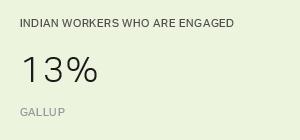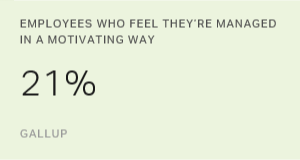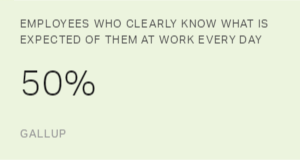As the Indian economy balances headwinds (GST, demonetization) and tailwinds (latest quarter's GDP growth, poverty reduction), this question keeps coming up: what is India's road to sustainable economic recovery?
Employment numbers show a serious problem: less than one-third of India's population works full time for an employer, and nearly half of the population is out of the workforce. Among the 15 to 29 year group, 50% are out of the workforce.
But the market outlook is bullish. The Indian stock markets, for the most part, have been resilient to short-term structural changes brought by the government. Most business leaders seem optimistic about the long-term future. Of course, the bourses are driven by investor sentiment, but company performance is driven by metrics.
Those metrics, however, may be insufficient. Earnings per share (EPS), revenue growth, etc., are lag indicators -- mostly outcomes dependent on other performance variables. They need to be tracked, but Gallup research indicates standard metrics often don't reflect a true picture of organizational health.
Further, inorganic growth -- via acquisitions and external market expansion programs -- certainly may grow the value of a firm in the near future, but it can take time to realize the true costs and benefits. In a short-term reality, based on quarter-to-quarter success, focusing on lag indicators and not factoring for the net long-term value of the creation of assets may be detrimental to the financial health of a firm and its shareholders.
The effect of such erroneous assessments can be seen in the abysmal state of public sector banking in India. As of 2017, most of the banks have an extraordinary percentage of non-performing assets (NPAs) due to unmanageable corporate debt. That's why they seek government bailouts.
This is not the road to sustainable recovery. Gallup research findings, however, may help national economies and company leadership shift their focus to a more productive set of metrics that can inform both social and corporate policy, improve employment numbers and create a more sustainable path to economic and corporate growth.
The Opportunity
To begin with, Gallup science subscribes strongly to the tenets of behavioral economics, as popularized by Nobel-Prize winners Daniel Kahneman (in 2002) and Richard Thaler (in 2017), which offers a better understanding of human decision-making. Human cognitive traits, for good or ill, heavily impact investment and disinvestment conversations and influence both individuals and the "herd." Gallup and other scientists find that leadership in any sector ought to take note of this information to improve their decision-making.
Educating leadership, rigorous coaching and seeking external advice can play a valuable role in timely policy course corrections. Further, Gallup advocates focusing on lead indicators that use behavioral economic effects and put greater emphasis on organic growth.
Organic growth involves strengthening the importance placed on metrics that track the internal realities of the "human system," and then extending these findings to the closest stakeholders. One such key metric is employee engagement.
Employee engagement is the emotional link between management and the workforce, an element that undoubtedly affects customers. Meta-analytic studies of the Gallup Q12 employee engagement data base indicate substantial gains in organizational success -- such as productivity, profitability, safety and retention -- in firms that effectively pursue this course.
The Problem
Family-owned businesses account for almost two-thirds of India's GDP and half the workforce. They, like many other private sector operations, usually operate in a patriarchal, command-and-control system, which curbs productivity and employee engagement.
Many traditional Indian organizations, including government agencies, have strong hierarchical structures that stifle innovation, misalign incentives and reward obedience more than outcomes.
Gallup science shows why. Gallup tracks the experience evaluation of Indian employees extensively, in both organized and non-organized labor sectors. The engaged in both sectors present higher levels of productivity, profitability, employee loyalty, advocacy, leadership confidence, overall life satisfaction, happiness and well-being.
But the average percentages of engagement are very low. Gallup's State of the Global Workplace report 2017 shows that only 13% of Indians, whether employed in the organized sector or otherwise, are engaged at work.
Meanwhile, the number of Indians who say their well-being is "thriving" is at an all-time low, and the percentage of Indians who are struggling to afford food is at an all-time high. India's government needs to pay particular attention to these percentages in its mission to create jobs and attract foreign investment -- engagement is a predictor of well-being, quality work, productivity and profitability.
Gallup's extensive research about millennials in the workplace is more relevant than ever, as it's forecasted that by 2021, more than 64% of India's workforce will be between 20 and 35. The State of the Global Workplace report indicates that this sector of the labor market shows pronounced apathy.
Though older generations are almost equally disengaged -- 13% of millennials are engaged, as are 14% of those born between 1965 and 1979 (Gen Xers) and 15% of those born between 1946 and 1964 (baby boomers) -- the sheer number of millennials in the workforce makes investing in engagement especially important. Understanding millennials' needs as contributing members of the workforce will be vital.
The Solution
It's true that India's economy is on an upswing. GDP growth is predicted to be 7.4% in 2018, and last November, The World Bank reported that India had improved in its "ease of doing business" rankings. To maintain that ranking and that growth, India must build success stories in local workforces by aligning workers with, and involving workers in, wealth creation. That requires tracking and improving employee engagement levels across the board.
Employee engagement won't fix all of India's problems, but it will make businesses perform better. Increasingly profitable performance is a primary component of organic growth and an expanding job market. Gallup science indicates, however, that the shifts required to achieve this are deeper than just structural -- they involve changing leadership's mindset.
As the Indian government spreads digitization and other financial mechanisms -- as emphasized by The World Bank and Gallup in their development of the global financial inclusion index (FINDEX) -- and reduces red tape to make investment in India more attractive, using leading behavioral metrics, such as workforce engagement and development, will be critical.
Companies naturally supplement growth efforts as well, and they, too, need to look beyond short-term market sentiment. To get on the road to recovery and stay there, businesses must appropriately assess and place value on lagging indicators while they train workers, coach managers, engage employees and take advantage of the vast potential that millennials in India offer.
Learn more about Gallup's global workforce study and discover how your organization can tap into human capital and revitalize productivity.
- Download Gallup's State of the Global Workplace report.
- Watch our on-demand webinar to get vital insights directly from our workplace experts.
- Listen to our podcast featuring Jim Harter, Gallup's chief scientist of workplace management, to hear his thoughts on what workers worldwide need from their bosses.
A version of this article first appeared in The Economic Times.
Jennifer Robison contributed to this article.




